
Notillveggies.org
The University of Maryland Extension Agriculture and Natural Resources Profitability Impact Team
proudly presents this bi-weekly publication for the commercial vegetable and fruit industry.
Volume 3 Issue 2 April 26, 2012
Spring Observations
from WyeREC
Strawberries:
Field-grown plasticulture Chandler berries began
By Michael Newell
ripening this week. Continue fertility management as
Horticultural Crop Program
indicated through leaf/petiole sampling and analysis.
Manager, UME
Sampling should be done every two weeks during
bloom and harvest.
Peaches:
Shuck fall is complete. Now and
Remember to consider resistant management when
for the next several weeks, this
choosing materials for disease and insect control.
is an important period for peach
Read and follow the label for all pesticides.
scab control. Sulfur can be used
for brown rot control at this
time, but materials that target scab (ie. Captan or others) should be used.
Spring Vegetable Crop Update
Fruit at this stage is also very susceptible to bacterial
Vegetable Crop Insects –
spot. Favorable conditions for epidemics include
Joanne Whalen, Extension IPM Specialist
persistent winds along with heavy rains or long
periods of moisture or humidity. Coppers or
Asparagus:
Terramycin should be applied any time wet and windy
Continue to check asparagus spears for eggs as
weather is expected.
Special Warning on
well as adult beetles feeding on spears. As a
Phytotoxicity: Be very careful when tank mixing
general guideline, a treatment is recommended
Captan and coppers. Captan/copper combinations
if 2% of the spears are infested with eggs. Since
should be avoided after long periods of overcast skies.
adults will also feed on the spears, a treatment
Also be careful with buffering solutions in tank mixes.
is recommended if 5% of the plants are infested
Cat-facing insects, (tarnished plant bugs and native
with adults. For a picture of asparagus beetle eggs,
stink bugs) can be more prevalent in orchards that
adults and larvae please refer to the following link:
have weedy or clover ground covers. The first line of
defense against these insects is a good ground cover
management program. Although pyrethroids can
provide good control of many insect pest at this time,
As soon as plants are set in the field, begin scouting for aphids, cucumber beetles and spider mites. When
expect mite populations to increase if pyrethroids are
sampling for aphids, be sure to watch for beneficial
insects as well since they can help to crash aphid
As a general guideline, a treatment should be applied
Bloom is almost complete in apples. Recent rains
for aphids when 20 percent of the plants are infested,
induced the first scab infection period with a 2nd
with at least 5 aphids per leaf but before populations
infection period predicted for this weekend. Sprays for
scab should also include materials for cedar-apple rust
Potatoes:
As soon as plants emerge, be sure to sample fields for
Later blooming varieties need to be protected for
Colorado potato beetle adults, especially if an at planting
FireBlight if weather conditions warrant anti-bacterial
material was not used.
A treatment should not be needed for adults until you
find 25 beetles per 50 plants and defoliation has reached
Local Governments • U.S. Department of Agriculture
It is the policy of the University of Maryland, College of Agriculture and Natural Resources, Maryland Agricultural Experiment Station, and University of
Maryland Extension that all persons have equal opportunity and access to programs and facilities without regard to race, color, gender, religion, national origin,
sexual orientation, age, marital or parental status, or disability.
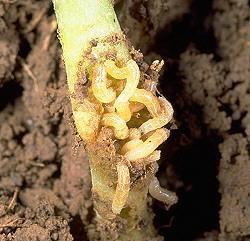

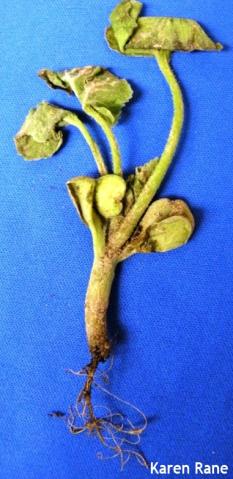
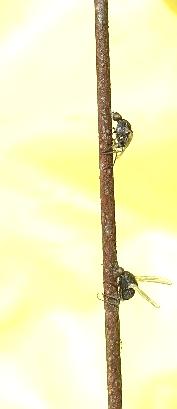
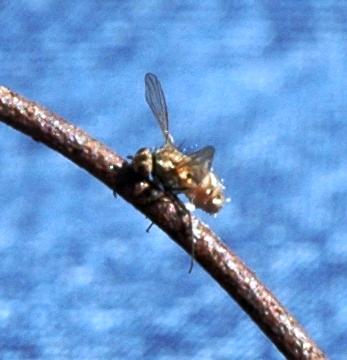
together by a few strands of plant material. The use of
Significant Seed Corn and Cabbage
treated seed or in-row banding of an insecticide gives
Maggot Damage Possible in the
some control of SCM, however, replacing dead transplants is the only solution after SCMs kill a plant.
Next Few Weeks
Once seed corn maggot damage is noticed, it is too late to apply control procedures. Thus, economic thresholds
Jerry Brust, IPM Vegetable Specialist
are not useful and all management options are
University of Maryland;
The unusually warm and dry spring we have had up to now has led many growers to transplant some of their
melon and other vegetable crops early. The cool wet
weather we have had in the last few days will make
some of these fields vulnerable to seed corn maggots
Delia platura (SCM) or less commonly found in cucurbit
fields cabbage maggots, Delia radicum (CM). Both
species overwinter in the soil as a maggot inside a
brown case. In March and April small, grayish-brown
Ric Bessin
flies emerge. Adult flies are most active from 10 a.m. –
2 p.m. and are inactive at night, in strong winds and
when temperatures are below 50o F or above 80o F.
Female cabbage maggot flies seek out and lay eggs on
the lower portions of stems of young host seedlings or in
nearby cracks in the soil. Within a few days the eggs
hatch and the tiny maggots burrow down to the roots
Ric Bessin
and begin feeding. SCM eggs are oviposited in soils with
decaying plant material or manure. The adults are also
attracted to the organic media around the roots of
transplants and germinating seeds. That is why fields
Figs 1, 2 and 3. Swollen stem of cucurbit plant with collapsed
that have been fumigated can still have problems with
rotting roots. When stem is cut open the white maggots often
can be found.
SCM. Maggots will move into small stems and move up
the plant causing a swelling of the stem just above ground level, while also causing root collapse and decay.
If these stems are split you will usually find the white cylindrical larvae (figs. 1, 2 and 3).
The adult flies are often found dead, stuck to vegetation during periods of warm wet weather (like we had in early April). These flies have been infected by a
fungus, Entomophthora sp. These infected flies usually
will be found at the top of a tall object in the field such
as a grass seed head or a field-flag (fig. 4). Just before the fungus kills them they cement their body via their
mouthparts to the tall object and die. If you look closely
you'll see the body is filled with the white fungus that
Fig 4 Two SCM flies killed by a fungus
has ruptured between the segments (fig. 5). Being on a
stuck to a field-flag via their mouthparts
tall object allows the spores of the fungus to move
longer distances and infect more flies than if the fly had
died on the ground. Even though we have had a dry spring, I still have seen many fungus infected dead flies this year. Unfortunately, the infection rate is not enough
to reduce the SCM population and stop infestations. Soil temperatures two inches deep in the planting hole
that are at or above 70o F reduce SCM egg laying and larval survival. If soil temperatures are above 70o F at planting but fall below this level for several days in a row
(which they have just done), SCM adults will begin to oviposit eggs at the base of transplants. When wilted
transplants are inspected in the field, maggots are often
not found (they have already pupated), but their tell-tale
Fig. 5 Adult SCM killed by a fungus - white strands coming out
damage can be seen as a hollowed out stem or root held
for Pythium in tomatoes as well as Previcur Flex
Scout Emerging Potato Fields for
(propamocarb HCL, 28) for the suppression of Pythium
and Phytopthora in tomatoes and peppers. Phosphite
Seed-Born Late Blight Infections
fungicides, such as ProPhyt and K-Phite (FRAC code 33)
Bob Mulrooney,
can also be applied as a pre-transplant drench in the
Extension Plant Pathologist; [email protected]
Additionally, there are a number of biologicals such as
There have been several reports of late blight
Trichoderma, Streptomyces, and Bacillus products which
from Florida. The most recent was a report from
can also be used in the greenhouse to help suppress
north Florida in the Hastings area that was identified
soil-borne pathogens. Remember, the biological need to
early, fungicides were applied and the situation is under
be applied without conventional fungicides.
control. This is a reminder that there was late blight in
At transplanting applications now include Ranman
many of the seed producing areas last season. In spite
(cyazofamid, 21) in the transplant water or through drip
of all the precautions and seed testing that occurs to
irrigation for Pythium control. There is a section 2ee for
reduce the chance of seed tuber infections, infections
the use of Previcur Flex (propamocarb HCL, 28) +
can occur if the weather is right and the seed is
Admire Pro (imidacloprid) in transplanting water for
Pythium control. Presidio (fluopicolide, 43) now has a
Be sure to be checking fields as they emerge for any
label for drip application for Phytophthora control when
seed born infections. Apply fungicide sprays of
conditions are favorable for disease development.
mancozeb or chlorothalonil once the plants begin to
Additionally, phosphate fungicides, Pro-Phyt and K-Phite
touch down the row. There is a late blight monitoring
(FRAC code 33) can also be applied through drip
website http://usablight.org/ that you can use to see
irrigation at transplanting to help suppress Phytophthora
what is happening around the country with late blight on
blight. Unlike in the past, there are a number of good
tomato and potato.
options for early season control of these pathogens, it
just takes a little bit more planning ahead of time. For
further details on use and crop labeled please refer to
Early Season
the specific fungicide label. Remember the label is
the law.
Pythium and Phytophthora
Control in Pepper and Tomato
Managing Forage Radish Cover
Andy Wyenandt, Specialist in Vegetable Pathology,
Crops that Fail to Winter-kill
Rutgers University;
Guihua Chen1, Ray Weil2 and Natalie Lounsbury2
University of Maryland, College Park
With the dry spring we've had thus far, it's easy to
Departments of Entomology1 and Environmental
forget about Pythium and Phytophthora! The same
Science and Technology2
question always comes up about this time of year when
growers begin to start thinking about transplanting their
Forage Radish and Winter-killing
tomato and pepper crops. "What should I do to help
Forage radish, a winter cover crop now widely
prevent Pythium and Phytophthora?". In years past, the
adopted by growers in the mid-Atlantic region, provides
answer was simple, apply mefenoxam (Ridomil Gold SL,
multiple and unique benefits, compared to other cover
Ultra Flourish, 4) or metalaxyl (MetaStar, 4). Problem
crops. One of its most attractive features is that it
solved, right? In the past, that answer was right, but
achieves multiple benefits during its fall growth and then
with resistance development in Phytophthora (P. capsici)
is normally winter-killed. Its early winter-kill and rapid
to both mefenoxam and metalaxyl, the correct answer
decomposition also provides weed free, warmer and
isn't so simple anymore. It's important to remember that
drier soil conditions in early spring. This eliminates the
both chemistries will work very well as long as resistance
need for tillage/herbicide and allows earlier spring
hasn't been detected on your farm.
How do you know if you have resistance? The
Generally, a cold period of several days with night
easiest way is to follow efficacy. If the chemistries no
time low temperatures below 20°F is required to
longer provide the control they once did, then there is a
completely kill forage radish. In Maryland, forage radish
good chance you have mefenoxam-insensitive
is usually frost-damaged in December and dies
Phytophthora populations present on your farm. There
completely during longer cold spells of January. The
are also lab services which test for resistance.
chances of achieving complete winter-kill can be
Remember, once resistance develops it can linger
increased by avoiding two conditions at cover crop
around for a very long time. Therefore, proper crop
planting that tend to make the plants less susceptible to
rotation and resistance management is critical before
frost. These are late planting and N deficiency. Younger,
resistance has the chance to develop. Our options for
later-planted and/or N-deficient forage radish plants will
pre-transplant applications include a Ranman
resist early frost damage. In addition, it seems to
(cyazofamid, 21) drench one week before transplanting
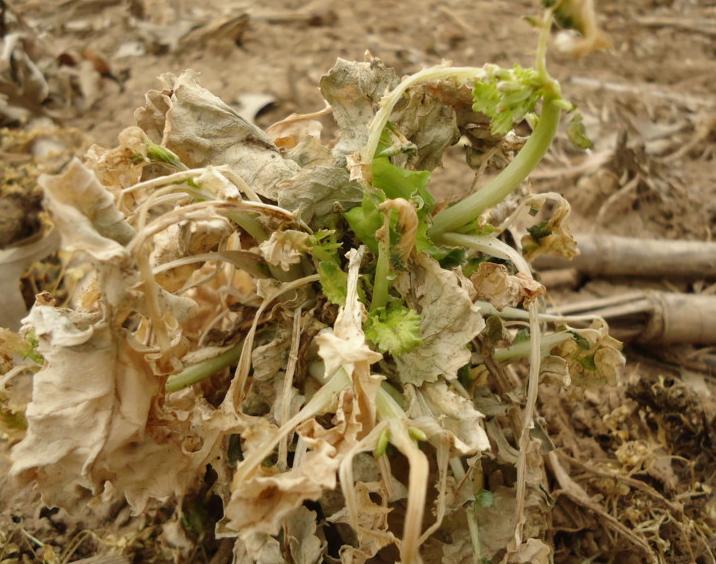
require less severe temps to kill the plants early in fall
additional assurance that the radish will not regrow.
than later in winter as the plants seem to increase their
Tillage is most effective in terminating the radish if it can
cold resistance with repeated exposure to mild freezing
be timed so that it is followed by a few dry sunny days.
temps as the winter progresses.
For non-organic systems, spraying a combination of
During the 12 year period (2000-2011) during which
2,4-D (one pint) with glyphosate (one quart) should
forage radish research was conducted in Maryland, good
terminate the radish plants. An alternative is Gramoxone
winter kill was observed in about 45 of 50 site-years of
(at 2.5 pints/acre) combined with 2,4-D (at 1 pint/acre).
research. Most of the instances in which forage radish
When sprayed in 14 gallons of water per acre with
re-grew in spring after partial frost damage in winter
7oz/acre of sticker, this combination gave complete kill
were in the lower eastern shore or locations protected
in less than a week (personal communication, Ron
from cold winds. However, between Dec 2011-Mar 2012
Ritter). Another option is 8 oz of dicamba plus 1.5 qt of
the eastern US experienced one of the warmest winters
glyphosate. If radishes were planted in a small grain
on record, with only four days (January 3, 4, 16, and 19)
crop, they can be killed in spring using 0.5 ounce of
when the minimum temperature dropped below 20°F as
Harmony Extra (old formulation) plus 0.5 pint of 2,4-D if
recorded at Beltsville, MD. (Figure 1). With this
applied before small grain is in its jointing stage
unusually warm winter, most of the forage radish in
(personal communication, Steve Groff). Radishes are
Maryland and other states in mid-Atlantic region was not
also easily controlled by in-crop cultivation and by a
completely winter- killed and grew back as temperatures
wide array of herbicides available for post-planting
rose in early March. Many farmers found they had green
application in such crops as corn or soybean.
cover crops where they were expecting only decaying
In short, while the appearance of green re-growth in a
residues. Some farmers had even interplanted forage
field that was supposed to be winter-killed may look
radish with their small grains. This situation created
worrisome, any fall-planted radish that survives the
much interest in how we can best terminate or manage
winter will bolt very early in spring and should be quite
forage radishes that failed to winter-kill.
Methods and time to kill non-winter-killed forage
radish cover crop
Winter 2007-2011 Average
In most cases, leaves re-grew on intact or partially
damaged roots or on the plants whose growing points
were not damaged because of slow growth in the fall
due to late planting and/or less available soil nitrogen.
However, spring growth of forage radish, especially if
tissues have been frost-damaged, is not nearly as
aggressive as in the fall. Forage radish is not nearly as
competitive in spring as other Brassicas, for example
rapeseed (canola), can be. It is also much easier to
terminate in spring than other Brassicas.
Even though a lot of green regrowth in March may
1-Nov 16-Nov 1-Dec 16-Dec 31-Dec 15-Jan 30-Jan 14-Feb 29-Feb 15-Mar 30-Mar
look scary, the forage radish regrowth is easy to manage
and should not pose any serious problems. Forage
Figure 1. Variation of minimum temperature in the winters of
2007 -2011 and winter 2011-2012 at Beltsville Agricultural
radish regrowth in early spring can be killed
Research Service, USDA, Maryland.
mechanically by mowing and/or tillage, or chemically by
herbicides. With any of these methods, it will be best to
wait for the radish to bolt – to send up a flower stalk. It is much easier to completely terminate the radish plants
in the bolting or flowering stage as compared to the vegetative stage. New shoots may regrow from tubers left alive below ground if it is killed during the vegetative
stage. Mowing is a practical method to terminate radishes in
spring without disturbing the soil by tillage. If mowing for no-till radish regrowth control, the mower should be
set as low as possible. One should avoid making tire tracks as far as possible - that is, it is best to mow when soil is firm and dry and the use of a side-mounted
mower would be ideal. Otherwise, some radish tubers will just be bent over by the tractor tires and then
missed by the mower blade. Mowing can completely
control regrowth if applied at the right time and stage of
Figure 2 Green regrowth from partially winter-killed radish
growth. Tillage after mowing can be used to provide
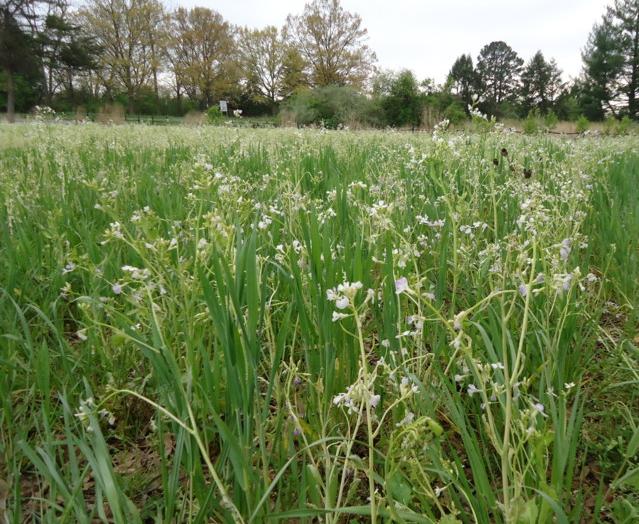
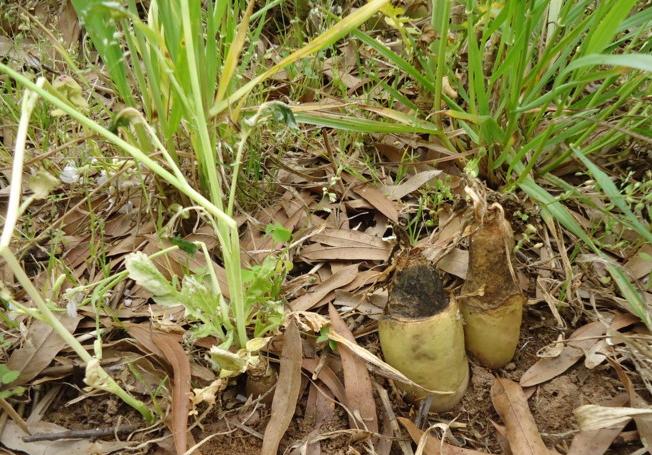
2012 Strawberry Twilight Meeting
Wednesday May 9th
6:00 – 8:00 PM
Wye Research and Education Center
211 Farm Lane
Queenstown MD
The 2012 Strawberry Twilight Meeting at the Wye
Figure 3. Radish mixed in small grain in spring after radish
Research and Education Center will be held Wednesday,
failed to winter-kill. This flowering stage is best time to
May 9, 2012 from 6:00-8:00 PM, rain or shine, at the
terminate the radish.
Farm Operations Complex, 211 Farm Lane, Queenstown,
MD. Directional signs will be posted. You'll hear University of Maryland and USDA small fruit
experts discuss the current season's challenges and the impact that the new fruit pest may have on the industry.
You'll see: USDA Moveable High Tunnel plots with plasticulture strawberry production; University of MD
Strawberry High Tunnel plots with table top production demonstration and bio-fumigation trial; and Outdoor Plasticulture Fertility Trial plots with Chandler
strawberries. We hope you can join us for an informative evening.
Pre-registration is not necessary. Refreshments will be served. For additional program information, contact Mike
Newell at 410-827-7388 or
Figure 4 Regrowth from some radish tubers but not from
If you need special assistance to attend this program,
others. Waiting until the radish bolts will make it much easier
to kill chemically or mechanically. These weak radish plants
please contact Debby Dant at 410-827-8056 or
will offer little competition even if they are left alive.
University of Delaware
Small Fruit Twilight
Tuesday, May 22, 2012 6:00-8:00 p.m.
Carvel Research and Education Center
16483 County Seat Highway
Figure 5. These non-winter-killed radishes were successfully
Georgetown, DE 19947
terminated with a mixture of Gramoxone and 2,4-D after they
had reached the flowering stage.
Participants will have the opportunity to tour
experimental plots and hear about current research on
June-bearing and day-neutral strawberries, blueberries
and blackberries. For additional program
information, contact Gordon Johnson at 302-856-
Commercial 2012
Vegetable & Fruit Headline News
Vegetable Productio
A bi-weekly publication for the commercial vegetable
and fruit industry available electronically in 2012 from
April through September on the following dates: April12 &
26; May 10 & 24; June 7 & 21; July 12 & 26; August 16; September 6
Maryland EB 236
On-Line at:
Published by the University of Maryland
Extension Agriculture and Natural Resources
Profitability Impact Team
Submit Articles to:
Also available in a new very interactive format
at the Delaware Extension site at:
R. David Myers, Extension Educator
Agriculture and Natural Resources
7320 Ritchie Highway, Suite 210
Glen Burnie, MD 21061
Article submission deadlines for 2012: April 11 & 25;
May 9 & 23; June 6 & 20; July 11 & 25; August 15; September 5
Note: Registered Trade Mark® Products, Manufacturers, or Companies
mentioned within this newsletter are not to be considered as sole
endorsements. The information has been provided for educational
purposes only.
Source: http://notillveggies.org/VegetableFruitHeadlines3-2.pdf
Research Article Pharmacovigilance and drug safety in Calabria (Italy): 2012 adverse events analysis Chiara Giofrè, Francesca Scicchitano, Caterina Palleria, Carmela Mazzitello, Miriam Ciriaco, Luca Gallelli, Laura Paletta, Giuseppina Marrazzo, Christian Leporini, Pasquale Ventrice, Claudia Carbone, Patanè, Stefania Esposito, Felisa Cilurzo, Orietta Staltari, Emilio Russo, Giovambattista De Sarro, and the UNIVIGIL CZ GroupDepartment of Science of Health, School of Medicine, University of Catanzaro, Italy and Pharmacovigilance's Centre Calabria Region, University Hospital Mater Domini, Catanzaro, Italy
Emergency Planning for the Peach Bottom Area Important Safety Information For Your Community And Annual Special Needs Survey Please read the entire brochure or have someone translate it for you. Discuss this information with members of your family, and then keep the brochure in a convenient place for future use.












